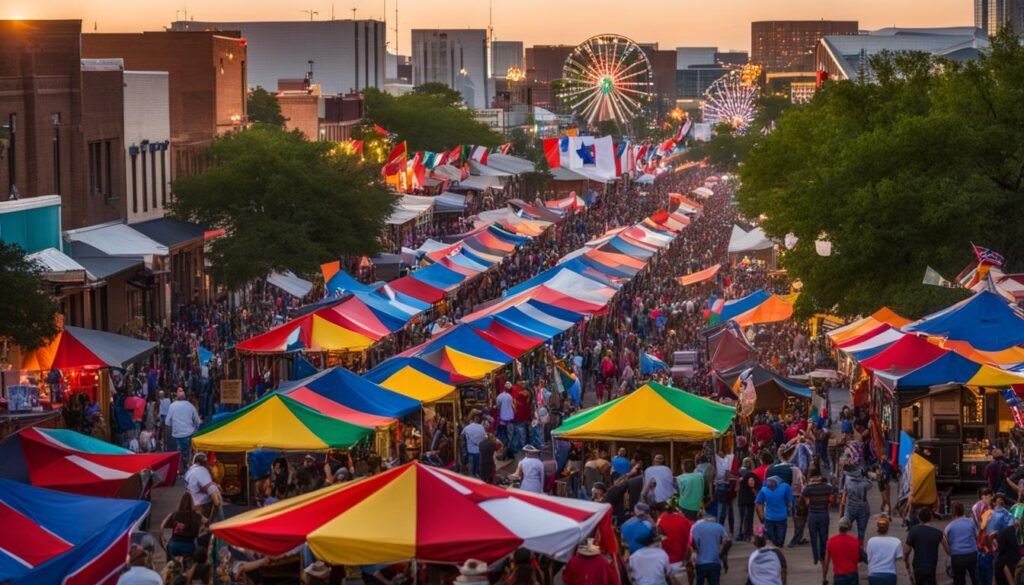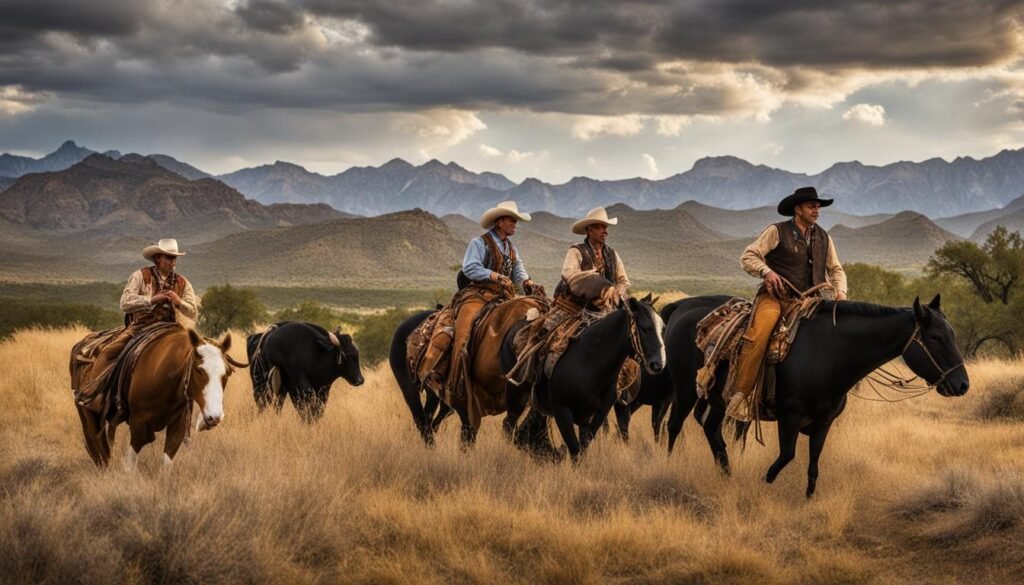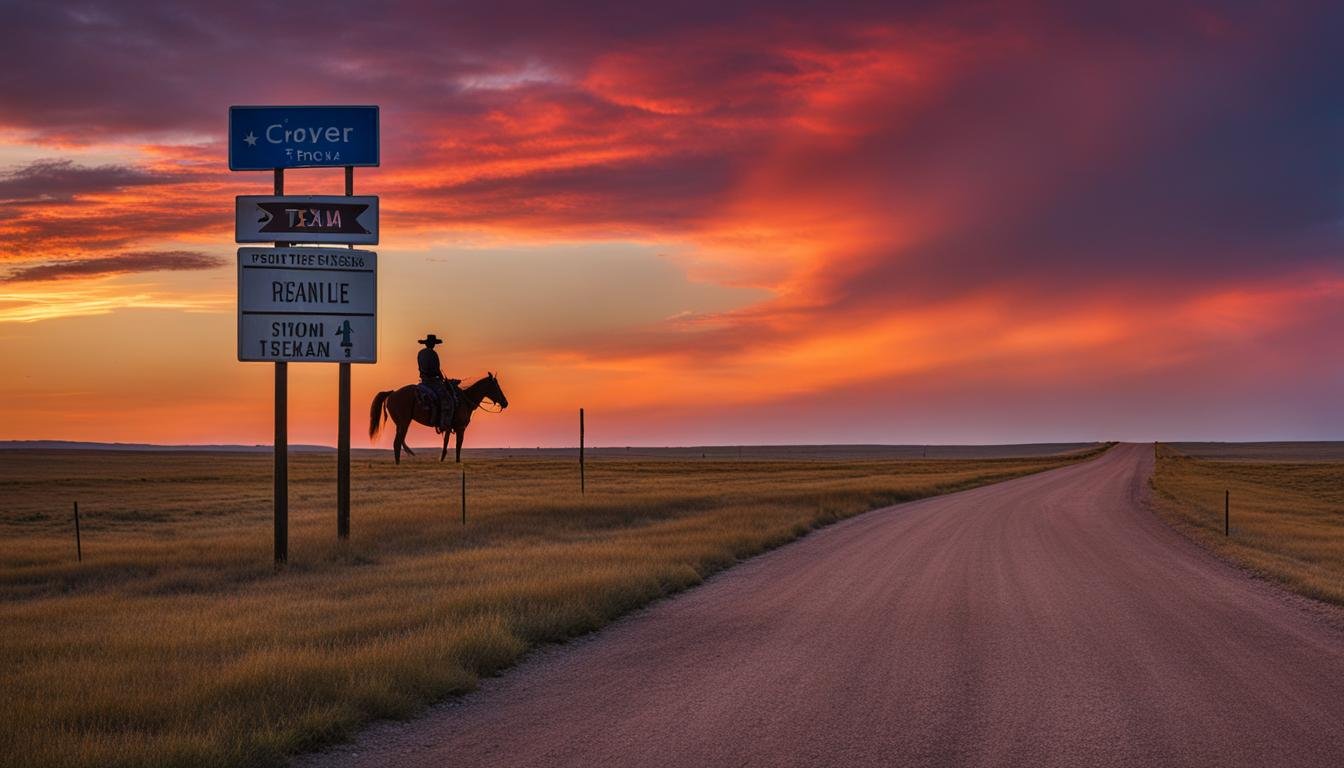Texas is a state known for its unique cultural diversity and vibrant way of life. Whether you’re relocating to Texas or simply looking to immerse yourself in the Texan spirit, understanding the cultural and lifestyle aspects of the state is essential. From the rich ethnic communities to the distinct regional identities, Texas offers a plethora of experiences that will enrich your life and help you embrace the Texan way of life.
Key Takeaways:
- Relocating to Texas involves adapting to the cultural and lifestyle aspects of the state.
- Texas is known for its diverse cultural heritage and regional identities.
- Embracing the Texan way of life requires an open mind and a willingness to immerse oneself in the local community.
- Participating in festivals, exploring the art and music scene, and understanding the rich history of Texas are essential for cultural adaptation.
- By appreciating the indigenous heritage and embracing the Texan sports culture, you can fully integrate into the vibrant Texan community.
Regions of Texas and their Cultural Norms
When it comes to cultural diversity, Texas boasts a vibrant tapestry of regional cultures. Understanding the unique cultural norms of each region is essential for those looking to adapt to the Texan way of life. Let’s delve into the distinct characteristics of East Texas, Central Texas, North Texas, South Texas, and West Texas.
East Texas
In East Texas, you’ll encounter a warm and welcoming atmosphere, as the region is known for its Southern hospitality. The piney woods, lush greenery, and charming communities contribute to the distinct charm of this area. East Texans take pride in their deep-rooted traditions and love for outdoor activities like fishing and hunting. Soak in the beauty of the natural surroundings and embrace the friendly demeanor of the locals.
Central Texas
Moving towards the heart of Texas, you’ll find Central Texas, a region that strikes a balance between urban development and natural beauty. The iconic city of Austin, often referred to as the “Live Music Capital of the World,” is a hub for creativity, arts, and culture. The Texan spirit thrives here, with a focus on live music, vibrant festivals, and a thriving food scene. Don’t miss the chance to indulge in authentic Tex-Mex cuisine and explore the unique blend of cultures that define Central Texas.
North Texas
In North Texas, the bustling metropolitan cities of Dallas and Fort Worth showcase the fast-paced and dynamic nature of this region. As the economic hub of Texas, North Texas is known for its diverse population and cosmopolitan lifestyle. This region is home to major sports teams, world-class museums, and a vibrant arts scene. Embrace the Texan passion for sports by catching a Dallas Cowboys football game or immerse yourself in the rich cultural offerings of the area.
South Texas
South Texas, also known as the Rio Grande Valley, is strongly influenced by its proximity to the Mexican border. The region is known for its vibrant Hispanic culture, which is reflected in its cuisine, music, and traditions. Explore the flavors of authentic Mexican food, dance to the lively rhythms of Tejano music, and celebrate colorful fiestas that showcase the area’s rich heritage. South Texas offers a unique fusion of Texan and Mexican cultures, creating a truly distinctive experience.
West Texas
Last but not least, West Texas captivates with its vast landscapes, wide-open spaces, and rugged cowboy culture. This region is characterized by its picturesque deserts, towering canyons, and breathtaking sunsets. Embrace the independent and self-reliant spirit of West Texas as you immerse yourself in the rich history of ranching and oil exploration. Discover the timeless beauty of places like Big Bend National Park and experience the true essence of the Wild West.
By understanding and appreciating the cultural norms of each region, you can fully embrace the diverse Texan spirit and seamlessly integrate into the local communities. Let the unique characteristics of each region ignite your curiosity and enrich your experience as you adapt to the Texan way of life.
Cultural Diversity in Texas
Texas is a vibrant and diverse state, renowned for its Texan cultural diversity and the rich heritage of its ethnic communities. From the strong Hispanic influence to the enduring African American culture and the German Texan heritage, the cultural tapestry of Texas is woven with various traditions, customs, and contributions.
Hispanic Influence in Texas
The Hispanic influence in Texas is deeply rooted in its history. As part of Mexico and Spain in the past, Texas is imbued with a distinctive Hispanic flair. This influence can be experienced in the vibrant celebrations, such as Cinco de Mayo and Día de los Muertos, which highlight the unique Hispanic cultural traditions. The delicious Tex-Mex cuisine, combining flavors from both Mexican and Texan culinary traditions, is beloved by locals and visitors alike. Furthermore, influential Hispanic figures have made significant contributions to various fields, including politics, arts, and sports, shaping the Texan identity.
African American Culture in Texas
African American culture has played a significant role in shaping the Texan identity. From the legacy of African American cowboys in the Old West to the influential contributions of African American musicians, artists, and leaders, Texas has a rich African American heritage. Prominent figures like Barbara Jordan and Beyoncé hail from Texas, demonstrating the deep-rooted impact of African American culture in the state. Festivals and events, such as Juneteenth, commemorate the end of slavery in the United States, allowing Texans to reflect on their shared history and celebrate the achievements of the African American community.
German Texan Heritage
The German Texan heritage has left a lasting imprint on the cultural fabric of Texas. German immigrants arrived in Texas in the 19th century, bringing their language, traditions, and customs. Today, their influence can still be seen in the architecture, cuisine, and festivals of the German Texan communities across the state. Cities like Fredericksburg and New Braunfels proudly celebrate their German heritage through vibrant Oktoberfest celebrations, traditional German cuisine, and the preservation of German language and culture.
Texan cultural diversity is a testament to the vibrant and inclusive nature of the state. Embracing and appreciating the various ethnic communities and their contributions is key to fully immersing oneself in the Texan way of life. By exploring the rich Hispanic influence, the enduring African American culture, and the lasting legacy of German Texan heritage, one can gain a deeper understanding and appreciation of the diverse cultural tapestry that makes Texas so unique.
Festivals and Traditions in Texas
One of the best ways to immerse yourself in the Texan culture is by participating in the various festivals and traditions that take place throughout the state. Texas is famous for its Fiesta season, a month-long celebration of Hispanic heritage that showcases lively parades, music, dancing, and delicious Texan cuisine. Other cultural traditions in Texas include the State Fair of Texas, known for its fried food and carnival rides, and Juneteenth, a commemoration of the end of slavery in the United States. By attending these festivals and engaging in the cultural traditions, you can fully experience the vibrant spirit of Texas.
Texan festivals offer a unique opportunity to celebrate the state’s rich cultural heritage and experience the Texan way of life. Let’s take a closer look at some of the most prominent festivals and traditions in Texas:
Fiesta San Antonio

Fiesta San Antonio is an annual citywide celebration held in San Antonio, Texas. This ten-day event features parades, music performances, art exhibitions, and a wide array of cultural activities. Highlighting the Hispanic heritage of Texas, Fiesta San Antonio is a vibrant and colorful festival that attracts millions of visitors each year.
State Fair of Texas
The State Fair of Texas is an iconic Texan tradition that takes place annually in Dallas. This cherished event is known for its thrilling carnival rides, livestock shows, and, of course, its irresistible fried food offerings. Attending the State Fair of Texas is a beloved tradition for many Texans, providing an opportunity to indulge in classic fair treats and enjoy a variety of entertainment options.
Juneteenth
Juneteenth is a historic celebration that commemorates the emancipation of enslaved African Americans in the United States. Originating in Texas, Juneteenth has become a vital cultural tradition in the state, featuring parades, musical performances, and educational events that emphasize the achievements and contributions of African Americans. This significant festival is an opportunity to honor the past and celebrate progress towards racial equality.
The Texan cuisine that accompanies these festivals and traditions is a treat for the taste buds. From mouthwatering barbecue to delectable Tex-Mex dishes, Texas offers a rich culinary experience that reflects its diverse heritage. Whether you’re savoring traditional Mexican flavors during Fiesta season or indulging in fairground delicacies at the State Fair of Texas, Texan cuisine is sure to leave a lasting impression.
| Festival/Tradition | Description |
|---|---|
| Fiesta San Antonio | A vibrant citywide celebration showcasing Hispanic heritage through parades, music, and cultural activities. |
| State Fair of Texas | An iconic Texan tradition featuring carnival rides, livestock shows, and a wide array of fried food delicacies. |
| Juneteenth | A historic commemoration of the end of slavery in the United States, celebrated through parades, music, and educational events. |
Participating in Texan festivals and embracing cultural traditions is a gateway to understanding the vibrant spirit of Texas. Whether you’re dancing in the streets during Fiesta San Antonio or exploring the diverse food offerings at the State Fair of Texas, these celebrations provide a unique opportunity to connect with the Texan community and create lasting memories.
Art and Music in Texas
When it comes to art and music, Texas boasts a vibrant and diverse scene that reflects the state’s rich cultural heritage. From Texan art exhibitions to live music performances in Austin, the Lone Star State offers a multitude of artistic and melodic experiences for enthusiasts and newcomers alike.
Austin, often referred to as the “Live Music Capital of the World,” is renowned for its thriving music scene. The city is home to numerous iconic music venues, including the legendary Austin City Limits and South by Southwest festivals. Whether you’re a fan of country, rock, blues, or any other genre, you’re sure to find a band or artist to suit your taste in the dynamic Austin music scene.
Texan musicians have made a significant impact on the music industry, with names like Willie Nelson, Beyoncé, and Stevie Ray Vaughan hailing from the Lone Star State. These influential artists have not only shaped the Texan music landscape but have also left a lasting cultural imprint on the global stage.
Texan art is equally captivating, with various galleries and exhibitions featuring works that celebrate the unique Texan spirit. Artists from different backgrounds and styles contribute to the Texan art scene, showcasing a blend of traditional, contemporary, and multicultural influences.
“Texan art and music are a testament to the diverse cultural fabric of the state. Through their creativity and expressions, Texan artists and musicians provide a window into the rich heritage and traditions that define Texas.” – Famous art critic
In addition to visual art and music, literature holds a prominent place in Texan culture. Texas has been the birthplace of many renowned authors and poets, including Laura Bush, Sandra Cisneros, and Larry McMurtry. Their literary works capture the essence of Texas, depicting the landscape, history, and people that make the state unique.
Literary Works in Texas
To delve into the literary treasures of Texas, here are a few notable works:
- “Lonesome Dove” by Larry McMurtry – A Pulitzer Prize-winning novel that explores the adventures of two former Texas Rangers on a cattle drive from Texas to Montana.
- “The House on Mango Street” by Sandra Cisneros – A coming-of-age novel that follows the story of a young Latina girl growing up in a Hispanic neighborhood in Chicago.
- “The Awakening” by Kate Chopin – Though set in Louisiana, this iconic feminist novella explores themes of women’s independence and self-discovery that resonate with the changing roles of women in late 19th-century Texas.
Exploring the vibrant art and music scene in Texas is not only an enjoyable experience but also an essential part of embracing the Texan way of life. It allows you to immerse yourself in the rich cultural tapestry of the state and appreciate the creative talents that have emerged from this diverse and inspiring region.
Historical Significance
Understanding the historical significance of Texas is crucial for adapting to the cultural and lifestyle aspects of the state. Texas has a rich history, including its time as an independent republic and its role in the American Old West.
Exploring museums and historical sites can provide valuable insights into the state’s past. One such museum is Frontier Texas!, which offers an interactive experience that immerses visitors in the history of the Texas frontier.
| Organizations | Details |
|---|---|
| Texas Historical Commission | Provides resources and information on Texas history, geography, and culture. |
| Texas State Historical Association | Offers resources and publications on Texas history, promoting the study and preservation of the state’s history. |
Embracing the folklore and legends of Texas is also important, as they contribute to the Texan identity and sense of heritage. From tales of the wild west to haunted ghost towns, the folklore of Texas adds depth and intrigue to its history.
“Texas history is not just about the past; it is the present and future. It shapes our identity as Texans and influences our culture in profound ways.” – Texas State Historical Association
By delving into the historical significance of Texas, you can gain a deeper understanding of the state’s culture and traditions, enriching your experience of adapting to the Texan way of life.

Sports and Recreation in Texas
Sports play a significant role in Texan culture, particularly football. Watching and participating in football is a favorite pastime for many Texans, with high school games, college games, and professional games drawing passionate crowds. Texas is home to numerous successful sports teams, including the Dallas Cowboys and the Houston Texans. Embracing the sports culture in Texas can help you connect with the local community and fully immerse yourself in the Texan way of life.
Football in Texas goes beyond just the professional level. High school football in Texas is a unique phenomenon that captures the state’s love for the sport. High school games attract huge crowds and enjoy a level of enthusiasm and support that is unmatched elsewhere. It’s not uncommon for small towns in Texas to shut down on Friday nights to watch their local high school team play. These games become community events, bringing people together to cheer on their teams and celebrate their shared Texan spirit.
Texan Sports Teams
| Team | Sport | City |
|---|---|---|
| Dallas Cowboys | Football | Dallas |
| Houston Texans | Football | Houston |
| Houston Rockets | Basketball | Houston |
| Texas Rangers | Baseball | Arlington |
| Dallas Mavericks | Basketball | Dallas |
These sports teams not only provide entertainment but also create a sense of pride and unity among Texan sports fans. Supporting a local team is a way to connect with fellow residents and bond over a shared passion. Whether you’re watching a game at a stadium or cheering from the comfort of your home, being part of the Texan sports culture is an experience that brings people together and celebrates the competitive spirit of the state.
Indigenous Heritage in Texas
Before European colonization, Texas was home to various American Indian tribes, each with their own distinct cultures and traditions. Understanding and respecting the indigenous heritage in Texas is essential for cultural adaptation and appreciation.
Some recognized tribes still have reservations in Texas, such as the Alabama-Coushatta, Tigua, and Kickapoo tribes. Learning about the history and contributions of these tribes can provide a deeper understanding of the cultural landscape in Texas.
Embracing the rich indigenous heritage in Texas promotes cultural diversity, fosters inclusivity, and honors the legacy of the original inhabitants of the land.

Recognized American Indian Tribes in Texas
| Tribal Name | Location |
|---|---|
| Alabama-Coushatta Tribe of Texas | Livingston, Texas |
| Ysleta Del Sur Pueblo (Tigua Tribe) | El Paso, Texas |
| Kickapoo Traditional Tribe of Texas | Eagle Pass, Texas |
“The preservation of our indigenous heritage is crucial for understanding the diverse cultural tapestry of Texas and ensuring a harmonious future for all.” – Chief Samantha Strong, Alabama-Coushatta Tribe of Texas
Conclusion
Embracing the cultural and lifestyle aspects of Texas is an exciting journey that allows individuals to immerse themselves in the vibrant Texan way of life. By understanding the regional cultural norms, participating in festivals and traditions, exploring art, music, history, sports, and embracing the indigenous heritage of Texas, one can fully integrate into the rich cultural diversity that makes Texas unique.
Cultural adaptation in Texas involves having an open mind and a willingness to embrace the Texan spirit. Whether relocating to Texas or simply wanting to fully experience the Texan way of life, immersing oneself in the diverse culture and community is essential. Exploring the different regions and their cultural nuances, participating in festivals and traditions, appreciating the vibrant art and music scene, and understanding the historical significance of Texas are all key elements in adapting to the Texan lifestyle.
Embracing the Texan way of life also means respecting and appreciating the indigenous heritage that enriches the state’s cultural landscape. By acknowledging the history and contributions of American Indian tribes in Texas, individuals can deepen their understanding of the Texan cultural fabric.
In conclusion, cultural adaptation in Texas involves embracing the Texan way of life through an appreciation of the diverse cultural aspects that shape the state’s identity. By immersing oneself in the Texan spirit, exploring various cultural elements, and actively participating in the local community, individuals can fully integrate into the vibrant Texan community and create meaningful connections.








